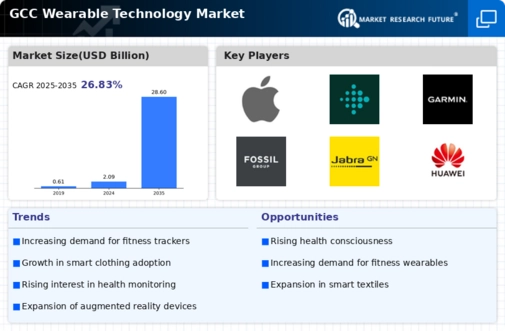The GCC Wearable Technology Market has emerged as a burgeoning sector characterized by intense competition and rapid advancements in technology. As consumer preferences evolve towards more integrated health and fitness solutions, a variety of companies are striving to capture market share through innovative product offerings tailored to the needs of consumers in the Gulf Cooperation Council region. This market encompasses a wide array of devices, including smartwatches, fitness trackers, and health monitoring gadgets, which are increasingly being integrated with mobile applications and enhanced connectivity features.
The growth of this market is also fueled by rising health awareness, the proliferation of smartphone usage, and the expanding reach of e-commerce, allowing for greater consumer access and engagement with wearable technology. Polar, a well-known player in the wearable tech market, has established a strong presence in the GCC region through its commitment to accuracy and cutting-edge technology. Renowned for its heart rate monitors and fitness watches, Polar has successfully leveraged its reputation to cater to the local population's fitness and health needs.
The company focuses on delivering comprehensive training solutions that combine hardware and software to support athletes and fitness enthusiasts. Polar's strengths lie in its extensive experience in sports technology, thorough research and development efforts, and user-friendly interfaces that appeal to both casual and dedicated users. Their products often exhibit high durability, making them suitable for varied climates within the GCC, thus building brand loyalty in a competitive market. TicWatch has carved out a prominent niche within the GCC Wearable Technology Market, primarily recognized for its innovative smartwatches that offer a blend of functionality and style.
The company’s key products encompass an array of smartwatches equipped with advanced health-tracking features, customizable interfaces, and seamless integration with smartphones. TicWatch’s market presence is bolstered by its commitment to integrating AI technology into its wearables, which enhances user experience and provides personalized insights. The company has strengthened its position in the GCC region through strategic partnerships focused on expanding distribution networks and enhancing local customer support. A significant strength of TicWatch lies in its competitive pricing strategy, making cutting-edge wearable technology accessible to a broader audience.
Additionally, their focus on continuous product improvement through research and development helps them remain adaptive to market trends and consumer preferences specific to the GCC context, thereby solidifying their presence in this growing industry.





















Leave a Comment